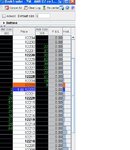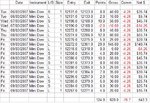Hi FW,
Didn't see this one until now.
Renko was no good on the short time frame - well not using the INDU at least.
There are so many ways to take a PERCEIVED entry signal, that it can get very confusing. One minute you see a Candle DT/DB working, the next you think the same Candle DT/DB formation is going to work, but as soon as you enter the market it reverses and turns into an engulfment in the opposite direction.
The balance may be a higher time frame - depending on what you are using for signals.
Probably more important, the sample set (no. of trades) needs to be completed to work out the Expectancy of the system - if the reader does not know about Expectancy then the chances of developing a consistent winning system will be very small - see Van Tharp's books.
I tend to jump the gun a little bit - mainly because I trust my intuition - and if I feel that my current setup is not going to work, regardless of sample trade set, then I will drop it after some short testing - as in my last few attempts which has cost me 100 YM points.
It is no good trying to get an Expectancy figure for a sample set based on bad entries - you must first get the entries right and then the sample set will tell you if the average will yield a good risk / reward ratio on a consistent basis.
Sometimes we tend to forget that every trade can be a loser, so even more important is to set your stop - and stick to it no matter what. When you start recording the trades in the sample set - you will see the R values for each trade - and your initial risk on each trade is always 1R.
To make it simple -you sample set of say 50 trades - must have losers that are not much greater than 1R - if you see losers that are 1.5 R and greater then you need to look closely at how you are working out your stops -and CHANGE it so that the majority of your losses are not much greater than 1R - in other words, you are sticking to your stops.
Likewise, your winners should be multiples of your initial 1R risk - 3R to 4R would be very good.
When you have completed your 50 trades, then with a simple automatic calculation on the Excel sheet you have your Expectancy of your system.
Most good long term systems will achieve an Expectancy of somewhere between 1.1 and 1.3 - depending on the markets and the system.
Once you know your Expectancy is positive (as a negative Expectancy is losing money of course) then you know exactly what your average risk/reward per trade will be.
It is then up to the trader to decide how many trades the want to put on - and this is why Daytrading can be so lucrative. With daytrading, as you are keeping your initial 1R risk very small - say 0.25% of available capital - and the average move for certain types of strategies can be as high as 100 to 150 cents - you can see right away the potential for very large gains.
For example - say you can do 10 trades in the first hour of trading - lets see the difference the Expectancy of your system makes.
Capital = $50K
Risk per trade - or 1R - = 0.25% or $125 per trade.
Note: The difference between your stop and your entry will determine how many shares you buy. For daytrading, as you are using LevII to get out fast, your stop wil be nearly always be the red level -No.4 - on the LevII screen.
Now watch what happens here depending on what the red band is offering:
Risk per trade = $125 Red Band Stop = 20 cent Shares = 625
Risk per trade = $125 Red Band Stop = 15 cent Shares = 833
Risk per trade = $125 Red Band Stop = 10 cent Shares = 1250
Risk per trade = $125 Red Band Stop = 05cent Shares = 2500
Now lets plug the values into our system with various Expectancy figures for the most conservative risk of 625 shares:
Trades = 10 Shares = 625 Expectancy = -1 P/L = $-6,250
Trades = 10 Shares = 625 Expectancy = -.5 P/L = $-3,125
Trades = 10 Shares = 625 Expectancy = .25 P/L = $1,562
Trades = 10 Shares = 625 Expectancy = .5 P/L = $3,125
Trades = 10 Shares = 625 Expectancy = 1 P/L = $6,250
Trades = 10 Shares = 625 Expectancy = 1.5 P/L = $9,375
Trades = 10 Shares = 625 Expectancy = 2 P/L = $12,500
See how much you can loose , as well as how much you can win, and this is for the conservative figure of 625 shares!
If you do not know what the Expectancy of your system is - then you should not be expecting to make substantial money in the markets.
Daytrading is where the big money is - as can be seen above - but you must have a good Expectancy figure - which is of course the hard part.
The next time a trader tells you he is very successful - ask him what is the Expectancy of his system -or what is his average R/R per trade. If he does not know, then he is either having a lucky streak that will more than likely not last, or he is lying.
Any professional daytraders - and I mean the boys who are making the big bucks $$$$$Mil - will definately know the Expectancy of their sytem.
Will they tell you - we will probably never know because thay are very few and far between -but there are some out there, that is for sure.
I would like to see Grey1's Expectancy figure - but I would guess that it is somewhere between
0.3 and 0.6. The only way to get the exact figure is to do a sample set of at least 200 trades - record the figures for every buy /sell taken.
You can actually set up a continual monitoring system with Excel very easily - but it must only be used for the same strategy - else the figures will not be accurate. I done this in the past -I will try and see if I can find the excel file and i will post same for discussion.
I will however, be creating a new one for my current attempts at trading the way I don't like trading - I am sure my current Expectancy figure is about -10 🙄


